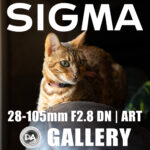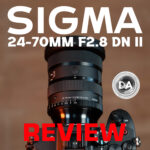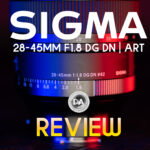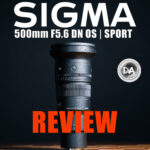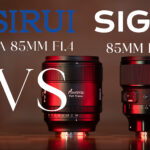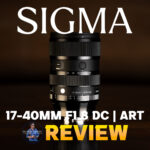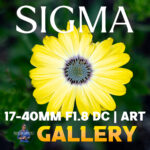
Sigma 28-105mm F2.8 DG DN | ART Review
I’ve been in the review business for about 13 years now, and over that time I’ve heard the requests from my audience for someone to produce a 24-105mm F2.8 full frame zoom. The 24-105mm F4 zoom has been ubiquitous, but always the F2.8 counterpart had a more constrained 24-70mm zoom range. That has lead to countless deliberations between the bigger zoom range of the 24-105mm or the larger maximum aperture of the 24-70mm zooms. But what people really want is, well, everything. Canon was the first to the table with their 24-105mm F2.8 L IS USM Z lens, though that lens will set you back $3000 and weighs 1.3 kilos. Not an “everyman’s lens”, for sure. But while Sigma’s newest lens is a little less ambitious – the Sigma 28-105mm F2.8 DG DN | ART lens – the price is just half of the Canon lens at $1499 USD. Does that make the 28-105 DN the new most desirable zoom out there? We’ll explore that question in either my video review below or in the text review that follows.
Follow Me @ YouTube | Patreon | Instagram | Facebook | DA Merchandise | Flickr | 500px | X
Thanks to Sigma Canada (Gentec) for sending me a review loaner of this lens. As always, this is a completely independent review. *The tests and most of the photos that I share as a part of my review cycle have been done with the Sony a7RV along with the Sony Alpha 1 that serve as my benchmark cameras for Sony lenses.
__________________________________________________________________________________________________
The top competitor to the new 28-105 DN on Sony will almost certainly be the Tamron 35-150mm F2-2.8 VXD. While the focal ranges are clearly not identical, both of them are traditional zoom range blurring high performance lenses. The Tamron has been my “if I only could have one lens” lens since it’s launch, and I use my copy extensively. I will draw some comparisons to the new Sigma lens, as I feel like both lenses are largely reaching for the same audience.

Sigma’s approach to keeping this lens at a reasonable size actually takes a page from the Tamron book; they’ve started at 28mm rather than 24mm. In this case, in fact, the 28mm wide end of the Sigma still trumps the 35mm wide end of the Tamron, though obviously the Tamron also happens to have an extra 45mm on the telephoto end. Which of those is more useful will probably mostly depend on your own shooting needs. That extra 20mm beyond 85mm does offer up some interesting portrait applications, allowing you a little more compression. But while Sigma is focused on portrait and landscape photographers in their marketing for the 28-105 DN, I think the most interesting market is actually event photographers (particularly wedding photographers). The Tamron 35-150mm has been my absolute go-to lens for all kinds of events because it includes the meat of both a 24-70mm and 70-200mm zoom. 35mm is very often wide enough in most venues, and being able to switch framing between wide and telephoto perspectives is incredibly useful. The Sigma allows for the same kind of approach in a slightly different way.

The Sigma 28-105 DN also adds some interesting close focus capabilities with a 0.32x magnification on the telephoto end, allowing for some “macro-ish” shots.

So does Sigma have a hit on their hands? We’ll dive in a little further to find out.
Build and Handling
Sigma’s build standards are continually evolving, and they have been very proactive about adding new features and improvements. Many of those feature improvements have been designed around video capture, which obviously serves this new lens well. The 28-105 DN has basically all of the features currently available on modern lenses save lens-based image stabilization.

That starts with the aperture ring (something relatively new for zoom lenses, period). The aperture ring works great, giving you precise control at 1/3rd stops when in clicked mode, and gliding smoothly through the whole aperture range when declicked.

On the lower left side of the lens is the Click/Declick switch which allows you to choose between those two options.

On the right side of the lens is the iris lock. The iris lock will allow you to either lock into or out of the aperture ring. For those that want to use the aperture ring and not inadvertently switch into camera based aperture control, the lock can be engaged while you are in the aperture ring and keep you there. If you’re not an aperture ring person you can switch the lens into the A position and control it from within the camera. Engaging the iris lock while in A assures that you won’t inadvertently bump into manual aperture control.

The left side of the lens also has an AF/MF switch (always appreciated!) along with one of the two custom/function buttons.

There’s a second function button on the top of the lens for access when shooting in a vertical position.

The function of those buttons (they are redundant, not two separate functions) can be set from within the camera.
Lower down the lens barrel is a lock to prevent zoom creep. This is an externally zooming lens, though the precision in the zoom mechanism and extending barrel means that there is little chance of zoom creep unless you have something specifically rubbing on the zoom ring (like when hiking, for example). The lock will only engage at the wide (28mm) setting.

The inner barrel extends roughly 43mm when zoomed out to the 105mm position, and I’ll note that the inner barrel feels very well engineered and smooth – no wobble.


It is worth noting that Sigma lenses zoom in the opposite direction of Sony lenses (and pretty much every other brand on E-mount). It’s a little annoying, actually.
The zoom ring is the closer of the two rings, with the manual focus ring further out. The manual focus ring is well executed, with wide ribbing and good damping. It makes for a good focus emulation, though as with all mirrorless autofocusing lenses this is focus by wire. Input to the focus ring is routed through the focus motor, and there are no hard stops at minimum focus or infinity.

The overall look of the lens is very much modern Sigma, with a lot of vertical lines and a few different textures.

This flows into the lens hood, which has a lock, a rubberized section for soft touch and a ribbed section for more grip when mounting or removing. Sigma’s lens hoods are nicer than just about any other brand. A padded nylon case is also included.

While I haven’t seen a cutout diagram of the weather sealing points, I do know that Sigma touts a professional grade of weather sealing on this lens. There is a gasket at the lens mount, a water and oil repellant coating on the front element, and internal seals throughout the lens. Sigma calls this a “dust and splash resistant structure”.

The basic dimensions of the lens (in Sony E-mount, as tested) are 87.8mm (3.5″) in diameter and 159.9 (6.3″) in length. It weighs in at 990g (34.9oz) and has an 82mm front filter thread. In many ways this lens has a similar physical size to the recent 28-45mm F1.8, though that lens is an internally zooming design.

To put this in context, the Tamron 35-150mm pictured here is 89.2 x 158 mm (very similar in size) but weighs 175g more.

The Canon 24-105mm F2.8L is the behemoth, however, at 88.5 x 199 mm and weighing 310g more. Bottom line is that Sigma has done a good job of managing the size and weight of the lens, though, to be fair, it doesn’t have quite as big of zoom range as either the Canon or the Tamron, and the Canon also has image stabilization while the Tamron sports a larger maximum aperture (F2-2.8) across its zoom range.
The aperture iris is unique for a Sigma lens, in that it has has 12 blades, which helps keep the aperture iris shape circular even with the lens stopped down.

This also produces a more defined 12 bladed sunstar, as while odd bladed apertures actually produce double the sun rays (an 11-bladed aperture has a sunstar with 22 points, but a 12-bladed aperture has 12 points. I personally favor the cleaner look of these sunbursts, though Sigma reports that this is more of a one-off with this lens and they have no plans to move to aperture irises with even blade counts.

The minimum focus distance 40cm, which allows for a very useful 0.32x (1:3:1) magnification at 105mm:

At 28mm, that 40cm produces this result:

But then you can zoom into 105mm and get a very different level of magnification.

This combined with that F2.8 aperture allows for very nicely blurred backgrounds, and up close performance is quite good.

Because I review a lot of Sigma lenses, there’s a lot that is familiar here, which makes it easy to take their excellence in design for granted. Sigma is packing as many features into their top lenses as anyone out there, and that’s fantastic in a lens that is equally good for both video and stills. This is a big lens, but as we’ve seen, it is actually a bit smaller and lighter than the competition. And, at a price of $1499 USD ($2099 here in Canada), it is not exorbitantly expensive (the Tamron 35-150 VXD runs $300-400 USD more).
Autofocus and Video
This is another area where Sigma has made some key strides. Their initial offerings on Sony (and L-mount) featured STM focus motors, but Sigma has since released their more powerful, smoother HLA focus motor (High speed Linear Actuator). The HLA motor has much more torque/thrust than lenses equipped with the stepping motor, which is very important when you are talking about a lens with larger, heavier optical glass like this one. The increased thrust of the focus motor means that it is capable of moving much faster and is thus much more reactive. Real world focus changes are essentially instantaneous, making this lens capable even of keeping up with some action. I used it with success at a rodeo, and while the lighting conditions meant that I didn’t always get as fast of shutter speeds as I would like, I was able to successfully track and capture the action.

This further increases the credentials of the 28-105 DN as a great choice for things like events or weddings, as even if there is some action, the autofocus can keep up.

Focus sound is basically nonexistent. The HLA motor is essentially silent even if I put my ear next to the lens. It is quiet enough that I literally looked up at the screen to make sure the lens was actually focusing.
Focus accuracy is good, too. I don’t really recall any shots during my review having been missed due to poor focus in any reasonable situation (I had a few times during the rodeo that focus grabbed the rail in front of me rather than the subject beyond, but that’s understandable).

Eye AF was excellent, delivering very accurate results whether photographing an animal…

…or a human subject.

I also saw mostly good results for video work. Autofocus pulls were very fast and confident. No hunting or settling. Focus is fast enough that you’ll probably want to slow it down in camera if you want more cinematic focus transitions. There is some focus breathing, though not extreme.
My hand test where I alternately blocked the camera’s view of my face with my hand and then remove it went quite well, with confident adjustments to and from my face.
I also found that in real world shots that focus changes tended to be more abrupt than what I would prefer. There’s a lot of thrust in this focus motor, but it probably would have been better to detune it a bit in video mode…particularly in a lens that will probably be highly desired for video work.
On a positive note, I used the 28-105 DN for about a half dozen of my YouTube video episodes, and focus was rock solid during those episodes.

Sigma’s HLA focus motors are great, though they are slightly limited on Sony by the fact that Sony limits bursts to 15FPS with third party lenses, so this one area where the 28-105 DN is not going to be as effective as the G Master zooms in certain applications.
Image Quality Breakdown
As I noted in my intro, this is a pretty special lens optically. The optical formula is fairly complex (18 elements in 13 groups), and that includes 2 FLD elements, 2 SLD elements, and 5 aspherical elements. A look at the MTF charts for the various lenses shows that the 28-105 DN holds up well when compared with either the 24-70mm F2.8 DN ART or older DSLR era 24-105mm F4 DG HSM lens.


At it’s best, the 28-105 DN is able to produce images with a lot of detail, contrast, and pop.

That’s not to say that the lens is flawless, however, as it does exhibit a few optical weaknesses. This is a very complex undertaking, and it becomes clear where the compromises were made. We not only maintain a constant F2.8 aperture (for full frame) in this zoom, but we go from moderately wide at 28mm to moderate telephoto at 105mm. Here’s a look at the same scene at all five marked positions on the lens (28, 35, 50, 70, and 105mm):





First, some of the good. There’s not much evidence of longitudinal chromatic aberrations (LoCA) here, with clean results before and after the plane of focus. There’s basically no evidence of fringing anywhere.

I shot photos of sunlight dancing through the morning dew, and I found all of those bright specular highlights clean of any fringing.

I also saw zero issues with LaCA (lateral chromatic aberrations), which shows up along the edges of the frame. All of the transitions here are very neutral.

While many people will certainly wish that this lens went as wide as 24mm, thus enabling photographers to more realistically use it for wide angle shots. The problem with going to 24mm (as Sigma has dealt with on their 24-70mm lenses) is that it is very difficult to control distortion, and those lenses have dealt with quite heavy barrel distortion at 24mm. The choice to only go as wide as 28mm should (in theory) allow for an easier optical design. Unfortunately the big zoom ratio of this lens has resulted in both a lot of distortion and a mildly complex distortion pattern.

I needed a very significant +26 to manually correct the distortion, though as you can see the correction isn’t linear. Getting the lines straight near the center results in the edges being pulled to a pincushion style distortion. Vignette is also very heavy, requiring a +90 to correct, which is just shy of maxing out the correction slider in Lightroom.
Sigma did provide me with a correction profile, and you can see that it essentially splits the difference on the distortion, leaving a bit of barrel distortion to avoid creating the pincushion distortion. It does clean up the vignette nicely.

There is unfortunately still a fairly significant amount of distortion (now pincushion style) on the telephoto end. Vignette is about a stop less (+61 to correct), and I needed a -10 to correct the distortion.

That’s enough distortion that I did notice it in some of my real world shots. If you look at the lines along the left side of this image you will see the curve due to the distortion. I saw this in a number of shots.

Again, the correction profile will take care of this, but it does show the area that had to give in the engineering compromises to make this lens happen.
So how about resolution and contrast? My formal tests are done on the 61MP Sony a7RV.
The MTF suggests that this is a very sharp lens in the center and mid-frame areas, with a typical corner drop-off at wide apertures. Is that what we see? Here’s a look at the test chart from which the crops come.

The MTF shows an accurate reflection of real world performance, as I find that, as suggested, the center looks amazing, mid-frame is very good, but the corners show a significant reduction in sharpness and contrast. Here are crops from across the frame at F2.8 and shown at a 200% magnification.



In most situations this probably won’t be a problem. Shooting at night or in a dimly lit venue it will be rare for this to affect things too much. I found that real world corners didn’t look terrible (this shot is 1/6th of a second, F2.8, ISO 3200).

This shot of fireworks at F2.8, 28mm looks nice and crisp.

The corners are somewhat better by F4, and reasonably good by F5.6, though they never quite rival the performance elsewhere in the frame.

It’s enough for real world shots to look good, however. Detail doesn’t jump off the page in a 100% crop of this shot, but you can see that it looks just fine, however.


Diffraction will set in at F11, and shots with apertures smaller than that will look noticeably softer. Here’s the difference between F11 and the minimum aperture of F22:

Moving on to 35mm finds the center performance largely the same, but I see some improvement in the midframe and the corners, though the corners remain softer by comparison.

Centering seems good in the lens, with consistent results in all four corners.
There’s more sharpness potential in the corners at 35mm, with corner performance looking quite good by F5.6.

If we move on 50mm, we find our strongest performance yet. Sharpness is noticeably higher in the midframe and corners (which look great!), and even the center looks a little better.

You can see that real world shots at 50mm show great detail and contrast.


70mm still looks good, though not as intensely good as 50mm.

At the end of the zoom range I find some give and take relative to 70mm. Some spots (midframe) look a little sharper, while the corners look a little softer and the center looks about the same. Overall I would say that sharpness and contrast are slightly lower at 105mm relative to other places in the zoom range.

Overall I found that sharpness was pretty good at 105mm for real world shots, though contrast isn’t top notch.


Here’s another example.

I did a few comparisons to the Tamron 35-150mm. Comparing the wide ends (28 vs 35mm) showed some give and take between the two lenses in terms of sharpness. The Tamron is sharper in the center and midframe, while the Sigma is very slightly sharper in the corners. At 105mm, the Tamron is a bit sharper all across the frame.

At least in the copies that I compared, I found that the Tamron had a little more capacity for further sharpening as you stopped it down as well. The comparison more strongly favors the Tamron at smaller apertures. The Tamron is also considerably more expensive, though it is impressive how well it holds up in this comparison three years after its release. After years of using the Tamron, I felt like the Sigma wasn’t quite as sharp and contrasty in real world applications.
So how about the bokeh? As with any zoom, that’s going to depend on the focal length. The telephoto end has the largest capacity for blurring out the background. You can see from this morning dew shot that bokeh looks fairly good.

There is some typical geometric deformation near the edges of the frame, and I also see some hints of “onion bokeh” there (concentric rings inside the specular highlights).
But while I found a slight bit of outlining in the specular highlights, I do feel like the some of the hard edges in this image are rendered fairly well. I have no real complaints here.

This casual portrait of me shows a little more busyness than what I would like in the textures of the trees beyond me.

I found the recent 28-45mm F1.8 zoom from Sigma to have some of the “special sauce” in the rendering, but I’m a little less impressed here.
Flare resistance, on the other hand, is excellent. I found very good resistance to veiling or ghosting, and I think the sunbursts look great!



This is an area of definite win over the Tamron, as it has a few issues with flare.
This allowed me to shoot right into the spotlights at the rodeo without concern that the images would be ruined.

Another plus is color rendition. I liked the overall look of images a lot. Skintones looked good, and other colors were rich.

Here’s another:

How about my truck at golden hour?

So while we don’t have a flawless performance here, we do have a very good optical showing. This is a very competent lens across all of its zoom range, which means that Sigma has pulled off something that really only one company has previously. And don’t forget that close focus ability, which allows you to pull off some unique images.

This ability could really expand the usefulness of the 28-105 DN as a wedding photographer’s primary lens, as you could grab detail shots of flowers, rings, and more without having to pull out a secondary macro lens. If you want to see more images, check out the image gallery for the lens here.
Conclusion
Genre busting lenses like the Sigma 28-105mm F2.8 DG DN | ART are rare for one simple reason: they just aren’t easy to make. There are so many constraints on the engineers, as they need to control the size, weight, and cost while also trying to engineer for optical excellence over a larger zoom range than is typical. Sigma is demonstrating their ability as a company to successfully take on exceptional challenges yet again. They were the first on Sony to do an F1.2 prime. The first to do F1.4 on a wide angle lens. The first to release a full frame F1.8 zoom. On and on the list goes, which shows just how far removed we are from the company once known for making budget alternatives to first party lenses. The 28-105 DN is yet another case in point.

Sigma’s HLA autofocus delivers excellent speed, allowing the 28-105 DN to also excel for action packed moments that lesser lenses might miss.

I can see this lens becoming a favorite for those who want a one-lens solution for events or portrait photography, allowing them to switch from wide angle to tighter framing with a twist of the zoom ring. The $1500 price tag seems a lot more reasonable when you consider that for many people it could probably replace both a 24-70 and a 70-200mm lens, particularly with the ability to switch to an APS-C crop on Sony’s higher resolution cameras. I’m not sure that it quite matches the versatility of the Tamron 35-150mm for my personal needs, but there are also several things that the Sigma does better. What a great day to be a photographer, however, when we are spoiled with one exceptional lens options upon another.

Pros:
- Genre busting zoom range with a constant F2.8 aperture
- Beautifully made
- Feature rich
- Thorough weather sealing
- Ability to declick aperture
- HLA focus motor is extremely quiet and has a lot of thrust
- Excellent focus accuracy
- Extremely sharp lens over most of the frame and zoom range
- Excellent flare resistance
- Near perfect control of aberrations
- Beautiful colors
- Excellent close focus abilities
- Very versatile lens
Cons:
- Distortion and vignette fairly high
- Corners on the wide end a little soft
- Bokeh can get a little busy
_________________________________________________________________________
GEAR USED:
Purchase the Sigma 28-105mm F2.8 ART @ B&H Photo | Adorama | Amazon | Camera Canada | Amazon Canada | Amazon UK | Amazon Germany
___________________________________________________________________
Purchase the Sony a7RV @ B&H Photo | Adorama | Amazon | Camera Canada | Sony Canada | Amazon Canada | Amazon UK | Amazon Germany
__________________________________________________________________
Purchase the Sony a7IV @ B&H Photo | Adorama | Amazon | Camera Canada | Sony Canada | Amazon Canada | Amazon UK | Amazon Germany
_________________________________________________________________
Purchase the Sony Alpha 1 @ Camera Canada | B&H Photo | Adorama | Amazon | Sony Canada | Amazon Canada | Amazon UK | Amazon Germany | Ebay
_________________________________________________________________
Want to support this channel? Use these affiliate links to shop at: B&H Photo | Amazon | Adorama | Camera Canada | Amazon Canada | Amazon UK | Ebay | Make a donation via Paypal
Buy DA Merchandise https://bit.ly/TWIMerch

Keywords: Sigma 28-105mm, DG, DN, ART, Sigma 28-105 F2.8, Sigma 28-105mm, F2.8, Sigma 28-105 Review, #SIGMAEmount, #SIGMA #SIGMA28105mmF28Art, #SIGMAArt, #SIGMADGDN, Full Frame, Review, Sony Alpha 1, Sony a7RV, Review, Hands On, Dustin Abbott, Real World, Comparison, Sharpness, Bokeh, Flare Resistance, Autofocus, Image Quality, Sample Images, Video, Photography, let the light in, weathersealing, #letthelightin, DA

